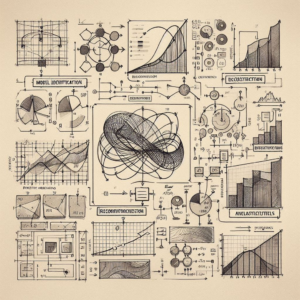
Model identification and reconstruction are crucial processes in fields like engineering, computer vision, and machine learning, particularly in cloud computing and artificial intelligence. These techniques help create mathematical models that analyze, simulate, and predict system behavior. This blog explores data modeling techniques, emphasizing methodologies, challenges, and applications in AI-powered environments.
1. Understanding Data Modeling in Cloud Computing and AI
Data modeling involves identifying and structuring data to enhance AI applications. Model identification plays a vital role in control systems, signal processing, and system dynamics, ensuring predictive accuracy in AI-driven environments.
1.1 Types of Data Models
AI applications utilize two primary types of models:
Parametric Models
These models have predefined structures with a finite set of parameters. The identification process estimates the best-fitting parameters based on data. Examples include:
– Linear regression models for predictive analytics
– ARIMA models for time-series forecasting
– Transfer function models in control systems
Non-parametric Models
Non-parametric models do not assume a fixed form and adapt based on data complexity. Common examples include:
– Neural networks, which dynamically adjust to data patterns
– Kernel methods, often used in classification tasks
– Gaussian processes, effective in uncertainty estimation
1.2 Techniques for Model Identification
Several techniques support AI-driven model identification:
– Least Squares Estimation (LSE): Minimizes errors in predictive models
– Maximum Likelihood Estimation (MLE): Optimizes model parameters for probability-based predictions
– Subspace Methods: Utilize matrix-based techniques for state-space model identification
– Machine Learning Approaches: Deep learning and ensemble methods for adaptive modeling
2. Model Reconstruction in AI and Cloud Computing
Model reconstruction refers to creating accurate representations of system dynamics using AI and cloud computing. This technique is widely used in robotics, simulation, and real-time decision-making.
2.1 The Reconstruction Process
The reconstruction process involves:
– Data Collection: Gathering structured and unstructured data from sensors, logs, or simulations
– Feature Extraction: Reducing data complexity and identifying key attributes
– Model Fitting: Applying optimization techniques for better accuracy
– Validation: Testing models against unseen data for reliability
2.2 Challenges in Model Reconstruction
– Noise and Uncertainty: Real-world data can introduce errors, requiring robust statistical techniques
– Overfitting: Overly complex models may fail to generalize; techniques like cross-validation mitigate this
– Computational Complexity: AI-driven modeling demands high processing power, often requiring cloud-based acceleration
3. Applications of Data Modeling in AI and Cloud Computing
Model identification and reconstruction have a wide range of applications across various domains, particularly in the UAE:
Control Systems: In control engineering, accurately identifying and reconstructing models of dynamic systems is crucial for designing effective controllers, especially when utilizing cloud computing resources.
Robotics: Robots often rely on reconstructed models of their environment to navigate and interact with objects. Techniques like simultaneous localization and mapping (SLAM) utilize model reconstruction for real-time decision-making.
Computer Vision: In computer vision, model reconstruction techniques create 3D representations of objects from 2D images. This process is fundamental in applications like augmented reality and autonomous vehicles.
Finance: In finance, model identification is used to create predictive models for stock prices, risk assessment, and portfolio optimization. This leverages cloud computing for data processing.
4. Recent Advances in AI-Based Model Identification and Reconstruction
Recent advancements in machine learning and artificial intelligence have significantly impacted model identification and reconstruction methodologies. Some notable trends include:
Deep Learning: Neural networks, particularly convolutional neural networks (CNNs) and recurrent neural networks (RNNs), have shown remarkable success in identifying complex patterns in data. These models can automatically learn feature representations, reducing the need for manual feature extraction.
Transfer Learning: This approach allows models trained on one task to adapt for another related task, improving efficiency and performance in model identification and reconstruction.
Generative Models: Techniques like Generative Adversarial Networks (GANs) and Variational Autoencoders (VAEs) are used to reconstruct high-dimensional data distributions. This enables more accurate modeling of complex systems.
Unsupervised Learning: Unsupervised learning methods are gaining traction for model identification, particularly where labeled data is scarce. These methods can learn representations from unlabelled data, making them suitable for real-world applications.
Conclusion
Data modeling is a fundamental aspect of AI-driven applications, providing structured methods for accurate predictions and decision-making. The evolution of Machine Learning Models for Model Identification and Reconstruction enables better adaptation to complex systems. As AI and cloud computing continue to advance, improving model accuracy and efficiency remains a priority. By leveraging deep learning, generative models, and transfer learning, industries can optimize AI-driven solutions, ensuring scalability and precision in real-world applications.
If you’re looking for AI-driven software solutions, Cloudastra Technologies can help. Visit our website for business inquiries and tailored AI strategies.
If you are looking for reliable software services, Cloudastra Technologies is here to help. Visit our website for more business inquiries and to learn how we can support your needs effectively.
Do you like to read more educational content? Read our blogs at Cloudastra Technologies or contact us for business enquiry at Cloudastra Contact Us.